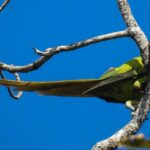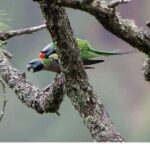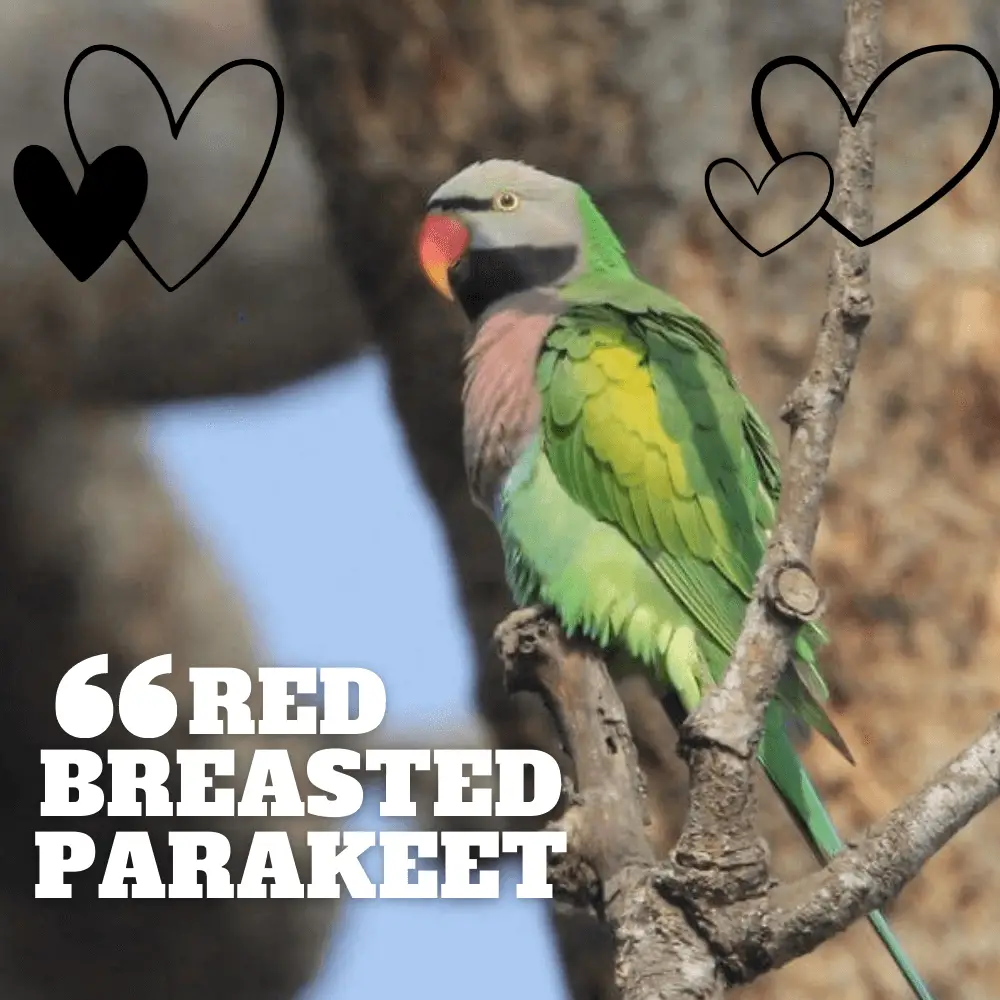
Red breasted Parakeet 33–38 cm; 133–168 g. Bill red, tipped yellow; head pale blue-grey with a thin black line from cere to the eye, black chin and lower cheeks; underparts pink from throat to mid-belly, then pale green; sides of neck, nape and upperparts green, with yellowish wash on median wing-coverts.
Red breasted parakeet female has duller pink underparts. Immature has green head and underparts. Race kangeanensis has less blue in the head, yellower wing-patch; dammermani larger; fasciata has a blue tinge to head, darker pink breast with a light blue wash, lower mandible blackish;
abbotti like fasciata but larger and paler; Cala like abbotti but less blue suffusion in pink; major like Cala but larger; perionca like major but slightly smaller, belly and vent brighter.
Editor’s Note: This article requires further editing work to merge existing content into the appropriate Subspecies sections. Please bear with us while this update takes place.
The closest relatives may be P. derbiana and P. caniceps, despite size differences. N subspecies fasciata is relatively distinctive for having bluish in head and breast,
whereas other subspecies have a grey head and clear pinkish breast, but black lower mandible of fasciata is shared by birds from W Sumatran islands; further research is needed. Eight subspecies were recognized.
SOURCE: Soumo’s Birdbook
Red Breasted Parrot Species
Introduced (nominate race) to Singapore and C Japan; in Singapore, breeding regularly since the mid-1980s. Borneo population is commonly considered introduced, but this is not necessarily correct.
Psittacula alexandri fasciata Scientific name definitions
P. a. fasciata+1
Distribution
Psittacula alexandri abbotti Scientific name definitions
Distribution
Psittacula alexandri cala Scientific name definitions
Distribution
Psittacula alexandri major Scientific name definitions
Distribution
Psittacula alexandri alexandri Scientific name definitions
P. a. alexandri+1
Distribution
Psittacula alexandri kangeanensis Scientific name definitions
Distribution
Psittacula alexandri dammermani Scientific name definitions
Distribution
Distribution
Editor’s Note: Additional distribution information for this taxon can be found in the ‘Subspecies’ article above. In the future, we will develop a range-wide distribution article.
Habitat
Moist deciduous forest, secondary growth, mangroves, teak and coconut plantations, woodland adjacent cultivation and villages, in foothill and lowland areas, generally avoiding dense evergreen closed-canopy forest.
Movement
Generally sedentary but with local irregular movements sometimes coinciding with red breasted parakeet food supply changes or, in N of range, periods of cold weather.
In a dry dipterocarp forest in W Thailand with high densities during the breeding period (3·8 birds/ha), there were almost no observations during the post-fledging period May–Aug.
Types of red breasted birds
SOURCE:
Diet and Foraging
Little specific information: nectar and flowers of Salmalia, Bombax, Butea, Parkia speciosa and Erythrina variegata, seeds of Albizia, chestnuts (Castanea), fruits of Ficus, bananas, leaf buds of teak, rice, and other grain recorded.
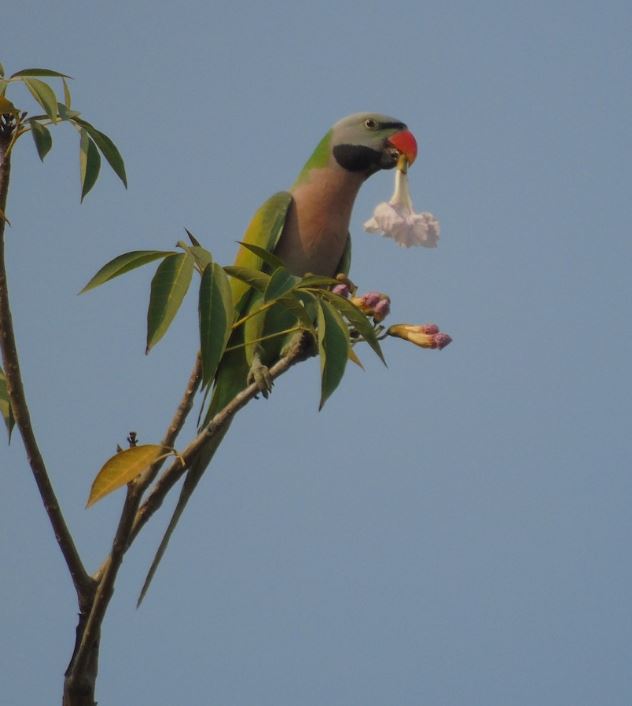
Sounds and Vocal Behavior
The commonest vocalization of red breasted parakeet is a short very nasal down slurred or over slurred squawk, often repeated in loose series or in fast bursts, e.g. “kyah…kyah..” or “keh. When perched, repertoire becomes more varied and includes a ringing “krrreeeah”, a scolding “screee” and various squabbling notes.
Breeding
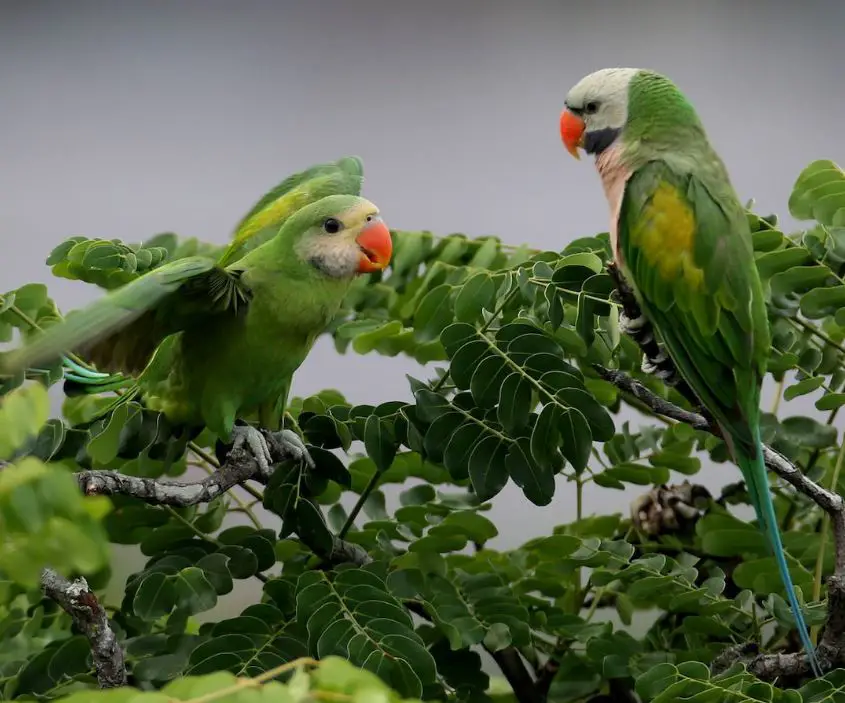
Generally, Dec-Apr in continental Asia, including Singapore and Andaman Is; every month but Apr on Java. red breasted parakeet Nest in a hollow limb or hole in a tree, often with several pairs occupying adjacent trees.
In a dry dipterocarp forest area in W Thailand, nine active nests were found between mid-Nov and mid-Apr, all cavities being in live excavated trees 3·5–11·8 m above ground, with minimum entrance diameter 5–8 cm.
Red breasted parakeet Eggs 3–4, size 29–31·9 mm × 24·1–24·6 mm (race abbotti); in captivity, incubation c. 28 days, and nestling period c. 50 days.

